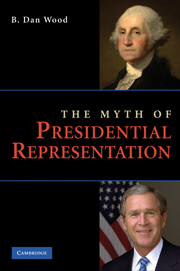Book contents
- Frontmatter
- Contents
- Figures and Tables
- Preface
- 1 The Nature of Presidential Representation
- 2 The Centrist and Partisan Theories of Presidential Representation
- 3 Measuring Mass Preferences and Presidential Issue Stances
- 4 Evaluating the Centrist versus Partisan Models of Presidential Representation
- 5 Presidential Persuasion and the Mass Public
- 6 Centrism, Partisanship, and Public Approval of the President's Job Performance
- 7 The Efficacy for American Democracy of Noncentrist, Partisan Presidential Representation
- References
- Index
- References
References
Published online by Cambridge University Press: 05 June 2012
- Frontmatter
- Contents
- Figures and Tables
- Preface
- 1 The Nature of Presidential Representation
- 2 The Centrist and Partisan Theories of Presidential Representation
- 3 Measuring Mass Preferences and Presidential Issue Stances
- 4 Evaluating the Centrist versus Partisan Models of Presidential Representation
- 5 Presidential Persuasion and the Mass Public
- 6 Centrism, Partisanship, and Public Approval of the President's Job Performance
- 7 The Efficacy for American Democracy of Noncentrist, Partisan Presidential Representation
- References
- Index
- References
Summary

Information
- Type
- Chapter
- Information
- The Myth of Presidential Representation , pp. 205 - 218Publisher: Cambridge University PressPrint publication year: 2009
